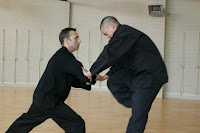The importance of visualisaton
I find visualisation essential in martial arts training: from learning new techniques, to applying them in a dynamic context. There was a time (2003) when I was confined to a hospital bed on a drip for 3 whole months. All I could do was visualise things. I used to look at the drip and think of it as an arm, with the bend as the elbow. Then I'd imagine locks or holds. I progressed to thinking of entire sequences in 3D (takes a bit of mental discipline and practice). It was during this time that I conceived of most of our 2 person drills. The net effect was that when I did return to training (some 20kg/44lb lighter) I was able to apply techniques I'd never applied before in sparring. The biggest "down side" to "just visualising" (apart from physical weakness) was that I couldn't judge speeds and distances properly, so I copped a few twisted fingers and broken toes as well as walking into a few punches, missing deflections etc. However once I got over...






